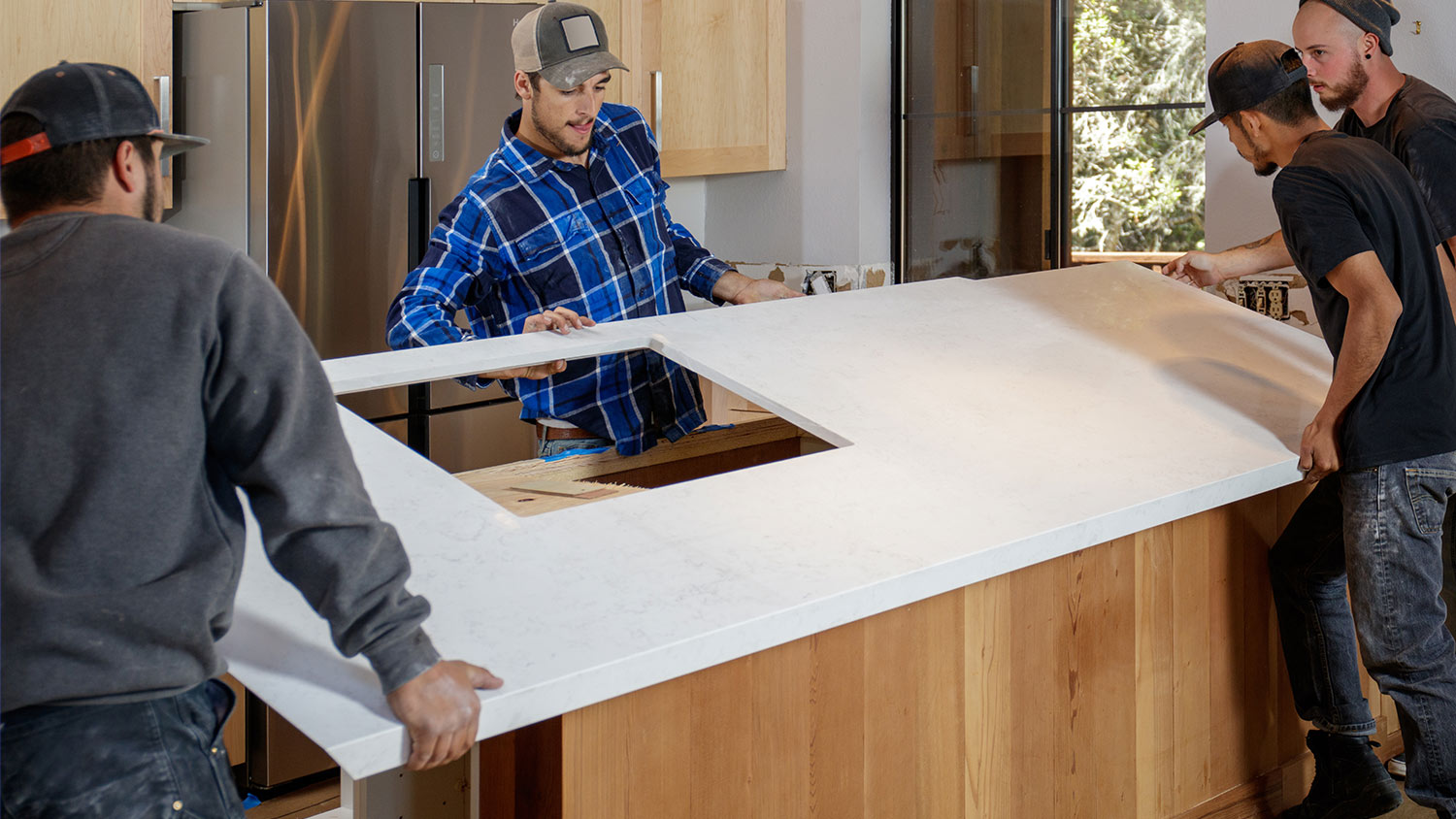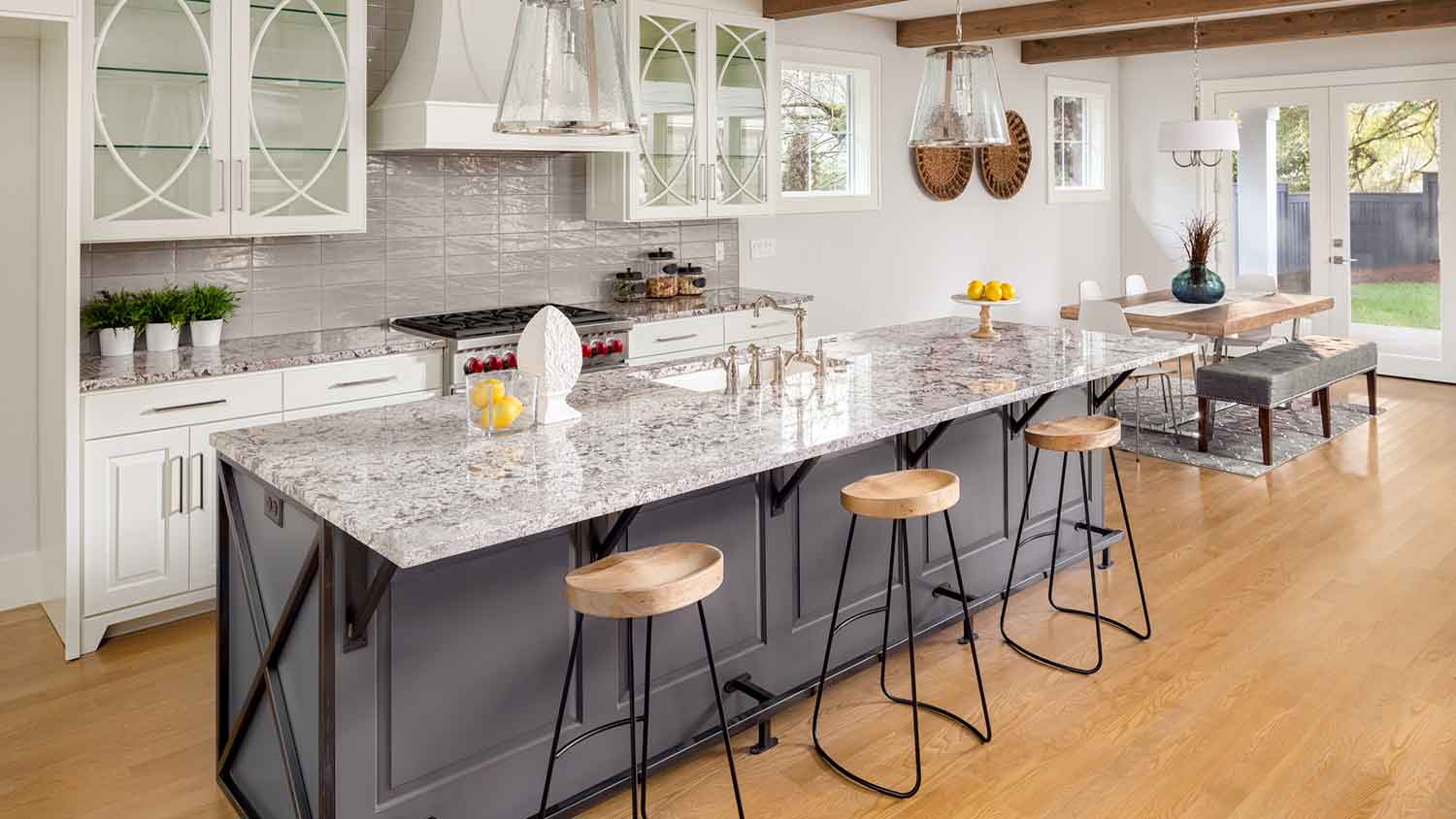
Discover cabinet installation cost estimates, including average prices, key cost factors, and tips to save on your new kitchen or bathroom cabinets.
Smooth the edges to create a countertop that combines durability with style


Solid surface countertops offer the look of natural stone without the weight and price tag of materials like marble or granite. You can learn how to cut solid surface countertops yourself. Most DIYers have the necessary tools, and if you’re patient with good attention to detail, this is a project you can tackle in a day.
Preparation for cutting solid surface countertops revolves around safety. This type of cutting creates a lot of dust. You’ll need safety goggles and a dust mask to prevent breathing in the particles. If you’re cutting the countertop inside your home, lay down a drop cloth or plastic sheeting to catch the dust.
The next part of preparation involves measuring the height, depth, and width of the area where you’ll install the countertop. Write the measurements down, and measure once more to make sure the numbers are accurate and ensure the accuracy of your cuts.
Secure the solid surface countertop (bottom side up) to a work table, set of sawhorses (with an area of overhang over both sawhorses), or cutting table using clamps. While these countertops aren’t as heavy as marble or granite, they’re still weighty. You’ll need to secure them so they won’t fall while you cut, and you may need a helper or two to lift the countertop.
You’ll mark the cut lines on the bottom side of the countertop so they’ll be hidden underneath the countertop if any remain after cutting.

Use the measurements you took in the preparation phase to create guidelines on the underside of the countertop (which should be facing up). Start with the depth measurements (from the front of the countertop to the back). Make marks using a pencil along one side of the countertop. After making several marks, use a carpenter’s square and straightedge to make a straight line between the marks.
Place the tape measure on the depth guideline you just drew and mark the length at the front or beginning of the countertop and again at the back or end of the depth mark. Use these two marks to draw the depth guideline on the opposite side of the countertop. Use the carpenter’s square and straightedge to draw the guidelines that connect the two short sides of the countertop. These will be your length guidelines.
After you’ve drawn the lines, check your original measurements and measure your lines again to make sure the depth and length match. Check the orientation with a carpenter’s square.
You can cut the countertop without a straightedge as a guide, but it provides extra guidance while cutting. You’ll put the base plate of the saw against the straightedge to support it and help get a straight cut.
Line up the straightedge to just beyond one of the guidelines. Clamp it in place so it won’t move while you cut.
Using a circular saw fit with a tungsten triple carbide blade (minimum 40 tooth), line up the cut line of your circular saw with the first guideline. Set the blade depth of the saw to at least 1/8 to 1/4 inch below the height of the solid surface countertop to ensure you cut all the way through the surface.
Don’t start your cut until the blade is moving at full speed. Then, make a rough cut on the guideline. Stop cutting, and let the saw rest if the friction between the blade and the countertop causes smoke. If you experience kickback, stop and start cutting again.

Repeat the clamping of the straightedge and cutting process on each guideline until you’ve cut the countertop to the necessary dimensions.
You’ll need to refine the rough cut edge left by the circular saw. Use a belt or orbital sander with 220-grit sandpaper to sand the edges of the countertop. You can manually sand the edges, but it can take a lot of time and effort.
Move to 320- and then 400-grit sandpaper to finish the countertop’s edges. The edges should be smooth, which you can check by running your fingers along the edges. You may need to continue sanding with finer and finer sandpaper to get the desired smoothness.
Round and refine the corners of the countertop with a sander. This is an inexpensive counter idea that adds a slightly different style to the countertop. If you like clean, 90-degree angles, you can skip this step.
Cutting solid surface countertops requires patience and precision. Careful measuring, securing, and clamping contribute to the project’s success. This type of countertop costs $25 to $70 per square foot, and solid surface countertop costs vary by brand.
The labor costs work out to around $50 to $80 per square foot. Cutting and installing the countertop yourself can save some cash, but it will probably take longer to make the cut and install the countertop than if you hired a pro to tackle the job.
A local Corian® countertop installer can get the job done in around six hours, for which you can expect to pay about $450. A pro may also remove the old countertop, make specialty cuts to fit appliances, and cut and line up backsplashes that might be too complicated for someone inexperienced with this material.
From average costs to expert advice, get all the answers you need to get your job done.

Discover cabinet installation cost estimates, including average prices, key cost factors, and tips to save on your new kitchen or bathroom cabinets.

Butcher block countertops are a popular and durable choice for active kitchens. Learn how much it costs to install butcher block counters and what factors may affect pricing.

Granite counters are durable and stylish, but if you’re wondering how much granite countertops cost, it’s time to dig into the details.

We share all the ins and outs for homeowners wondering how to epoxy countertops. Our tips will help you avoid all of the common project pitfalls.

Installing countertops is grueling work, so leaving a tip for your countertop installers is always an appreciated gesture—but how much depends on the quality of work.

When doing a kitchen remodel, expenses add up quickly. You can cut your costs down by removing your own countertops. Here’s how to remove a countertop safely.